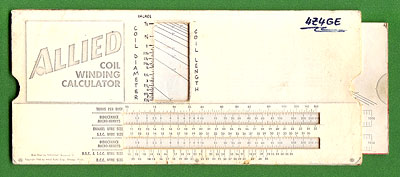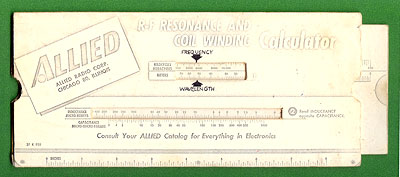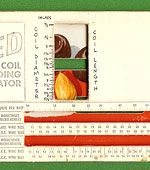 |
|
|
|

|

|
The Xeroxed calculator |
|
|
|
|
of all the layers. I then produced a fairly accurate replica of
the coil calculator and used it happily for many years. One side of this slide chart handles the simple computation of resonant frequency and wavelength from the capacitance and inductance in an LC circuit. But of more interest is the much higher sophistication of the other side, with its sliding set of graphs in the top window and its numerous fixed scales (top photo). This embodies more complexity than one usually sees in slide charts. Furthermore, it illustrates the big advantage of analog calculating aids over digital ones: you can get a grasp of the “big picture”. An electronic calculator may tell you that a coil of such and such dimensions will have an inductance of nine micro-henrys; but you’ll have to redo the entire calculation to answer a question such as “Could I still get this inductance with a narrower diameter while keeping the length reasonable?” or “What wire size will give me the required turns-per-inch?” or “How fast does the required wire size change if I increase the desired inductance? How about if I replace enameled wire with D.C.C. wire?” The slide chart gives you all these “what ifs” and more, along a continuum, at a glance. |
|
|
|
Incidentally, the original I worked from seems to have been a promotional item advertising the Allied Radio Corporation, and produced for them in 1960 by the Perrygraf company. This last specialized in producing cardboard "slide chart" and "wheel chart" calculators that were sold to companies as advertising give-aways; and it still does that today. A look at their web site will show an amazing range of simple, effective devices that can help you with anything from watching those calories to figuring mortgage payments. In fact, these simple computing devices are every bit as useful and elegant today as they were in 1934, when Lester Perry started his company. |
|
|
|
Home | HOC | Fractals | Miscellany | About | Contact Copyright © 2007 N. Zeldes. All rights reserved. |
|


